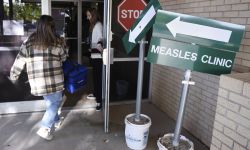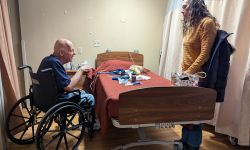Michigan’s Upper Peninsula getting hit hard by surge of coronavirus cases

Counties in the western Upper Peninsula, some without hospitals, are battling rising cases of COVID-19, with the region experiencing the highest rates of new infections of any area in Michigan — and some of the highest ever seen outside metro Detroit.
In September alone, Houghton County had nearly four times as many cases — 244 — as the 66 it had recorded in the first five months of the pandemic.
Delta County saw its cases more than double in September. It recorded its sixth and seventh deaths on Thursday, said Michael Snyder, health officer for Delta and Menominee counties.
- Unfazed by crises, northern Michigan embraces Trump record on jobs, abortion
- Pandemic brings record crowds to Michigan parks. (And trash and trouble)
- The latest: Michigan coronavirus unemployment, map, curve, updated COVID-19 news
- Dashboard: Michigan coronavirus testing numbers, trends, COVID-19 data
Snyder said 11 Delta County residents are in hospitals in Delta County or in northeastern Wisconsin. That’s up from an average of one or two on a typical day a couple of weeks ago, he said.
“What we’re seeing in Delta and Menominee counties is a significant increase in the number of COVID-19 cases,” Snyder said.
Heightened case counts have also hit Iron and Dickinson counties.
In Houghton County, many of the new cases are tied to college students at Michigan Tech University in Houghton, but now those cases have spread into the community where students shop, work and recreate, said Kate Beer, health officer for the Western Upper Peninsula Health Department that covers several counties.
“Houghton is the real hotspot right now,” Beer said. “It was [students at] Tech but now we’re seeing community spread. [Students] work here, they shop here; their relationship extends beyond the campus borders.”
So far, the demography of the new infections, typically younger students and some grade-school students in a couple of counties, has helped limit the impact on the region’s health-care system, Beer said.
Younger patients with COVID-19 have tended to require hospitalization less frequently. But many are still going to the emergency room: state data show the Upper Peninsula has had one of the highest rates recently of COVID-19 emergency room visits.
What worries Beer is if those young cases start moving through the community and start reaching the most vulnerable. Almost all of the Upper Peninsula has a higher percentage of senior citizens than much of the southern part of the state and they are more prone to poor outcomes. The median age of the state’s 6,700 deaths has been 77.
“I’m getting a little concerned if we see more of a spread into our vulnerable population, our elderly population,” Beer said.
From March until July, there were under 150 cases total across the vast, 15-county region of the Upper Peninsula. Northern Michigan politicians called for — and ultimately got — some relief from some of Gov. Gretchen Whitmer’s restrictions aimed at limiting the spread of the disease.
But infections in the U.P. started to rise in July, when there were 351 cases, many of them in Marquette and Gogebic counties. In August, there were 467 new cases. And in just over three weeks, there have been 825 new cases in September, including 84 new cases reported just Thursday in five western U.P. counties.
Snyder and Beer both noted the region’s cross-border traffic with Wisconsin, where restrictions imposed by the governor were struck down by the state Supreme Court, allowing bars and restaurants to reopen.
That led to rising cases (Wisconsin set records for the number of cases and hospitalizations this week) that have steadily moved north out of Green Bay and, now, across the border into Michigan. Many Western U.P. residents work in Wisconsin, and shop and go to bars and restaurants there.
“It was like a wave northward,” Snyder said.
In raw numbers, the coronavirus case counts are low compared to cases recorded in some counties in the southern part of Michigan, such as Wayne, Oakland and Macomb Counties. But the U.P. counties are sparsely populated, and also have comparatively few health care facilities, which are spread across the region.
The Upper Peninsula has recorded about 180 cases for every 100,000 people in September. That’s the highest rate in the state, edging out the nine-county region that includes Ingham County, where there have been over 1,200 cases at Michigan State University alone, and Lenawee County, which has seen an outbreak at Adrian College.
Since March, that rate has only been exceeded a few times, and most often in metro Detroit, where tens of thousands of cases led to the loss of thousands of lives in March, April and May.
Since Sept. 1, the rate in metro Detroit is about 100 cases per 100,000 people.
There have been outbreaks reported at two Menominee County public schools, and Snyder said there have been cases, not necessarily linked so not considered an outbreak, at other schools.
Both Snyder and Beer said they are working with schools, most of which are conducting face-to-face classes, on ensuring safety. And they’re working with their peers on potential solutions, while keeping an eye on personal protective equipment for health care workers.
“We’re trying to figure out the next step right now,” Beer said.
See what new members are saying about why they donated to Bridge Michigan:
- “In order for this information to be accurate and unbiased it must be underwritten by its readers, not by special interests.” - Larry S.
- “Not many other media sources report on the topics Bridge does.” - Susan B.
- “Your journalism is outstanding and rare these days.” - Mark S.
If you want to ensure the future of nonpartisan, nonprofit Michigan journalism, please become a member today. You, too, will be asked why you donated and maybe we'll feature your quote next time!








